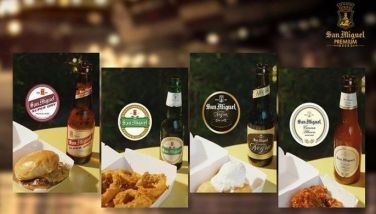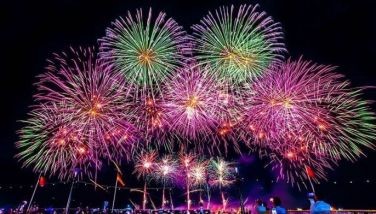Waxing cultural in Bangkok
June 30, 2001 | 12:00am
 On a recent trip to Thailand, I met up with old friends from Cambridge University. Boonhiang was a scholar in Biochemistry, and his chemist wife Pom accompanied him during the four years it took to complete his research on protein engineering. Kat, their three-year-old daughter, was born during that time. We became friends while sharing accommodations in a sprawling Victorian house owned by our college, Gonville and Caius. Pom’s wonderful cooking eased the lives of those who enjoyed her dinners. As a result, the pressures of our academic lives seemed more bearable.
On a recent trip to Thailand, I met up with old friends from Cambridge University. Boonhiang was a scholar in Biochemistry, and his chemist wife Pom accompanied him during the four years it took to complete his research on protein engineering. Kat, their three-year-old daughter, was born during that time. We became friends while sharing accommodations in a sprawling Victorian house owned by our college, Gonville and Caius. Pom’s wonderful cooking eased the lives of those who enjoyed her dinners. As a result, the pressures of our academic lives seemed more bearable.
So seeing them again brought back all those warm memories. Thais are hospitable everywhere they go, but they are exceptional when at home.
In Bangkok, Pom and Boonhiang had a whole day’s itinerary set out for me. They first took me to the Salaya campus of Mahidol University. It is some 20 miles away from central Bangkok and the site of Boonhiang’s office in the Ministry of Science. After a simple but tasty lunch in a café smelling of cake, we went to a wax museum.
"They say it’s like London’s Madame Tussaud’s," Boonhiang uneasily qualifies. Soon, I found it was much more than that.
Surrounded by pleasant ponds and gardens, the Human Imagery Museum has mostly local tourists (incidentally, non-Thais are charged a higher entrance fee). At least that was the scene when we visited on a Sunday afternoon. The museum brochure is in Thai but the texts accompanying the exhibitions have English translations.
The private, social history museum’s long-winded name immediately tells visitors that it does not have Madame Tussaud’s theme park ambience. The Bangkok wax museum achieves a balance that few museums do: that is, to strike a compromise between information and entertainment.
At the heart of its popularity are elements important to Thais: Buddhism, the King and their history. In between these, tableaus also depict life-sized wax figures of ordinary Thais taken from everyday, local scenes. There are hardly obstacles or platforms on which the figures stand, so visitors can simply walk up to them and have their pictures taken.
On the first floor are wax figures of important Buddhist monks. Most of them are seated in the lotus position, looking serene and poised. Furniture and objects around them are familiar and common. The same is true for local scenes or slices from domestic life like men playing a board game. The folk in these tableaus are wearing typical, everyday clothes.
At turns, I felt slightly startled by some of these figures because they were rendered so life-like. They do not photograph well, however, since the camera flash makes them look, well, waxen.
The grimmest part of the museum is on the second floor. Here the history of slavery in Thailand and elsewhere is shown. Perhaps partly wanting to exonerate themselves as the only group in the world who practiced vassalage, the exhibit shows where human labor was traded. It starts with the best examples, including a tableau of shackled black Africans walking in rows.
In the beginning I was nonplussed by the existence of slavery in Thailand but soon realized that all those astonishing temples and shrines in sites like Ayutthaya and Phuttamonton would not have been built without enslaving legions of human beings.
It took King Rama V to begin abating slavery in Thailand and by "1905 there (was) no more slave trading but it took 33 years to completely abolish (it)." Slavery was so entrenched in Thai society that children, as depicted in one of the tableaus, were paid to winners in village gambling games.
Social hierarchy remains part of contemporary Thai culture where the idea of knowing your place is practiced. Some expatriate friends would attribute Thailand’s rebounding economy as partly due to people’s perseverance, service-orientation and sense of community.
At the center of all this is King Bhumibol, the revered head of Thailand. Large photographs of the king are scattered along streets and other public places, showing him in different settings and poses that "look like they were taken out of the pages of GQ magazine," as my friend would remark. Along with his ancestors, Bhumibol is featured in the wax exhibit. But unlike them he is represented in royal regalia, standing on a stage with his consorts against an ornate backdrop. For ordinary mortals and having had no chance to pay respects to the King at the royal palace, this is a sight to behold.
 Behind the hall showing the spectacle of an all-male royal entourage is a tall room showing the King’s mother regally poised as if ready to receive those paying their respects. Most of the older Thai visitors who see her image in wax greet her in typical fashion, clasping their hands as if in prayer and touching their foreheads while they bow. Having died recently, her achievements particularly in the fields of health and medicine are shown in large posters found in the room.
Behind the hall showing the spectacle of an all-male royal entourage is a tall room showing the King’s mother regally poised as if ready to receive those paying their respects. Most of the older Thai visitors who see her image in wax greet her in typical fashion, clasping their hands as if in prayer and touching their foreheads while they bow. Having died recently, her achievements particularly in the fields of health and medicine are shown in large posters found in the room.
I have heard that Thais appreciate and respect the royal family, particularly their King, that at one point when Thailand’s financial situation became dire, wealthy Thais donated their jewelry and other valuables upon the King’s appeal to help their country’s economy. From this perspective, it is easy to understand why they refused to shoot the plebeian Hollywood film Anna and the King there.
The most popular Thai poet, Sunthorn Phu, represents the best in Thai literature. He was royal page to the monk Prince Phathomwongse and then King Rama II. According to the text beside his figure, he died in 2398 but it gives no clue of its equivalent in the Gregorian calendar which we use. I had forgotten to ask my Thai friends. On his 200th year anniversary, the wax museum mounted this permanent exhibition to honor Phu after being named by UNESCO as the people’s poet. His famous tale, Phra Abhaimiani, is in rhyme. According to the museum, "it consists of traveling rhymes, five tales, two proverbs, one play, two song recitals and four sleeping songs." Fantastic characters from them are portrayed in a tableau across his wax figure. They reminded me how writers and artists can stretch their imagination and inspire others with their creations.
Games children and adults play in villages were selected to represent the typical Thai culture. There are five sets of them in this area and according to the museum, these "sculptural art" are now made with fiberglass.
Easily the most colorful – especially with the traditional clothing and the actions frozen in wax tableaus – many visitors usually dally in this area. One interesting game portrayed is called "Bald Head Smashing." Its name probably comes from uneasy translations but its depiction make it look painfully fun. Adult visitors tell to accompanying children about the games which perhaps are no longer played in cities like Bangkok.
Likening the Human Imagery Museum to Madame Tussaud’s Wax Museum is unfair not because its quality falters in comparison to its European counterpart. Tussaud’s is easily the most popular museum in the UK today even at a ticket price of more than £10 (or P800) because of the many superstar personalities featured in wax. Princess Di’s image is represented, so are Michael Jackson and Arnold Schwarzenegger’s. Tourists queue up outside of the entrance of this private museum for a chance to be photographed next to Liz Taylor and other renowned figures.
In contrast, the Thai wax museum is less glittery and tends to focus more on interesting aspects of Thai identity. It gives an outsider a better picture of who the Thais are – and not only because of the wax figures but also because of the local visitors who outnumber foreign ones.
The museum is not typically found in tourists’ itineraries around Bangkok. Rather, like my experience, it was my Thai friends Pom and Boonhiang who brought me there. They even drove me around the wide highway called Park-Utthiyan, which is decorated with rows of lamps designed to look like the stylized female bird Kinari. Locals call this "the road that leads to nowhere" and was meant to honor the King’s 50th anniversary. One side of it actually leads to Phutthamonton, which is a big Buddhist center with lots of monuments and shrines. Having gone around this area outside Bangkok and hearing what local people have to say, it made me glad I was taken off the beaten tourist track.
BrandSpace Articles
<
>



















